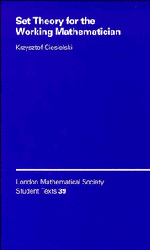Book contents
7 - Strange real functions
from Part III - The power of recursive definitions
Published online by Cambridge University Press: 05 June 2012
Summary
This chapter is designed to help the reader to master the technique of recursive definitions. Thus, most of the examples presented will involve constructions by transfinite induction.
Measurable and nonmeasurable functions
Let B be a σ-algebra on ℝn. A function f: ℝ → ℝ is said to be a B-measurable function if f-1(U) ∈ B for every open set U ⊂ ℝ. Notice that if f is B-measurable then f-1(B) ∈ B for every Borel set B ⊂ ℝ. This is the case since the family {B ⊂ ℝ: f-1(B) ∈ B} is a σ-algebra containing all open sets.
We will use this notion mainly for the σ-algebras of Borel, Lebesguemeasurable, and Baire subsets of ℝn, respectively. In each of these cases B-measurable functions will be termed, respectively, as Borel functions (or Borel-measurable functions), measurable functions (or Lebesgue-measurable functions), and Baire functions (or Baire-measurable functions). Clearly, every continuous function is Borel-measurable and every Borel-measurable function is measurable and Baire.
A function f: ℝn → ℝ is non-Borel (or non-Borel-measurable) if it is not Borel. Similarly, we define non-Baire (-measurable) functions and non-(Lebesgue-)measurable functions.
Also recall that the characteristic function χA of a subset A of a set X is defined by putting χA(x) = 1 if x ∈ A and χA(x) = 0 for x ∈ X \ A.
The first theorem is a corollary to Theorems 6.3.7 and 6.3.8.
- Type
- Chapter
- Information
- Set Theory for the Working Mathematician , pp. 104 - 126Publisher: Cambridge University PressPrint publication year: 1997



